135 film
135 film, better known as 35 mm film, is a format of photographic film used for still photography. It is a cartridge film with a film gauge of 35 mm (1.4 in), typically used for hand-held photography in 35 mm film cameras. Its engineering standard for the film is controlled by ISO 1007.[1]

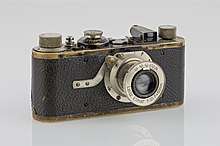
The term 135 (ISO 1007) was introduced by Kodak in 1934[2] as a designation for the cassette for 35 mm film, specifically for still photography. It quickly grew in popularity, surpassing 120 film by the late 1960s to become the most popular photographic film size. Despite competition from formats such as 828, 126, 110, and APS, it remains so today.
135 camera film always comes perforated with Kodak Standard perforations.
The size of the 135 film frame has been adopted by many high-end digital single-lens reflex and digital mirrorless cameras, commonly referred to as "full frame". Even though the format is much smaller than historical medium format and large format film, it is much larger than image sensors in most compact cameras and smart phone cameras.
Characteristics
Cassette
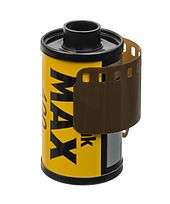
Individual rolls of 135 film are enclosed in single-spool, light-tight, metal cassettes to allow cameras to be loaded in daylight. The film is clipped or taped to a spool and exits via a slot lined with flocking. The end of the film is cut on one side to form a leader. It has the same dimensions and perforation pitch as 35 mm movie print film (also called "long pitch", KS-1870, whereas 35mm professional motion picture camera films are always "short pitch", BH-1866).
Most cameras require the film to be rewound before the camera is opened. Some motorized cameras unwind the film fully upon loading and then expose the images in reverse order, returning the film to the cassette; this protects all images except the last one or two, should the camera back be accidentally opened. Disposable cameras use the same technique so that the user does not have to rewind.
Since the 1980s, film cassettes have been marked with a DX encoding 6-digit barcode pattern, which identifies the manufacturer and film type (and thus processing method), and the number of exposures, for the use of photofinishing laboratories. The cassettes are also manufactured with a Camera Auto Sensing code constructed as two rows of six rectangular areas on the metal cassette surface which are either conductive or insulating, representing 32 possible film speeds, 8 possible film lengths, and 4 possible values of exposure tolerance or latitude. Conforming cameras detect at least some of these areas; only 3 contacts are needed to set a light meter for the 4 most popular film speeds.
Film type and speed
135 film has been made in several emulsion types and sensitivities (film speeds), standardised by ISO. Since the introduction of digital cameras the most usual films have colour emulsions of ISO 100/21° to ISO 800/30°. Films of lower sensitivity (and better picture quality) and higher sensitivity (for low light) are for more specialist purposes. There are colour and monochrome films, negative and positive. Monochrome film is usually panchromatic; orthochromatic has fallen out of use. Film designed to be sensitive to infrared radiation can be obtained, both monochrome and with false-colour (or pseudocolour) rendition. More exotic emulsions have been available in 135 than other roll-film sizes.
Image format

The term 135 format usually refers to a 36×24 mm film format, commonly known as 35mm format. The 36×24 mm format is common to digital image sensors, where it is typically referred to as full frame format.
On 135 film, the longer dimension of the 36×24 mm frame runs parallel to the length of the film. The perforation size and pitch are according to the standard specification KS-1870. For each frame, the film advances 8 perforations. This is specified as 38.00 mm. This allows for 2 mm gaps between frames. Camera models typically have different locations for the sprocket which advances the film. Therefore, each camera model's frame may vary in position relative to the perforations. The film is approximately 0.14 mm thick.
Other image formats have been applied to 135 film, such as the half-frame format of 18×24 mm which earned some popularity in the 1960s, and the 24×24 mm of the Robot cameras. The successful range of Olympus Pen F cameras utilized the smaller half-frame size, allowing the design of a very compact SLR camera. Unusual formats include the 24×32 mm and 24×34 mm on the early Nikon rangefinders, and 24×23 mm for use with some stereo cameras. In 1967, the Soviet KMZ factory introduced a 24×58 mm panoramic format with its Horizont camera (descendants of which are called, in the Roman alphabet, Horizon). In 1998, Hasselblad and Fuji introduced a 24×65 mm panoramic format with the XPan/TX-1 camera. There is also a 21×14 mm format used by Tessina subminiature camera.
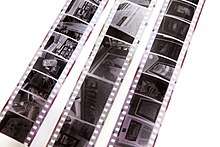
Length
The film is available in lengths for varying numbers of exposures. The standard full-length roll has always been 36 exposures (assuming a standard 24×36 frame size). Through about 1980, 20 exposure rolls were the only shorter length with widespread availability. Since then, 20 exposure rolls have been largely discontinued in favour of 24 and 12 exposure rolls. With most cameras it is possible to get up to 3 more exposures than the nominal capacity on the film if the camera is loaded in a darkroom and some cameras allow this with daylight loading. 27 exposure disposable cameras are loaded in the dark with standard 24 exposure cassette.
Other, mostly shorter lengths have been manufactured. There have been some 6, 8, 10, and 15 exposure rolls given away as samples, sometimes in disposable cameras, or used by insurance adjusters to document damage claims. 12 exposure rolls have been used widely in the daily press. Photographers who load their own cassettes can use any length of film – with thinner film base up to 45 exposures will fit.
Ilford at one time made HP5 black-and-white film on a thin polyester base, which allowed 72 exposures in a single cassette.[3] They produced special reels and tanks to allow this to be processed.
History
35 mm still cameras
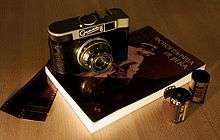
The 135 film size is derived from earlier still cameras using lengths of 35 mm cine film, the same size as, but with different perforations than, 135 film. The 35 mm film standard for motion picture film was established in Thomas Edison's lab by William Kennedy Laurie Dickson. Dickson took 70 mm film stock supplied by George Eastman's Eastman Kodak Company. The 70 mm film was cut lengthwise into two equal width (35 mm) strips, spliced together end to end, and then perforated along both edges. The original picture size was 18×24 mm (half the full frame size later used in still photography). There were four perforations on each side of a motion picture frame.
While the Leica camera popularized the format, several 35 mm still cameras used perforated movie film before the Leica was introduced in the 1920s. The first patent for one was issued to Leo, Audobard and Baradat in England in 1908. The first full-scale production camera was the Homeos, a stereo camera, produced by Jules Richard in 1913, and was sold until 1920. It took 18x24 mm stereo pairs, using two Tessar lenses.
In 1909, the French Étienne Mollier designed a device small-format photography, the "Cent-Vues", which used the 35 mm perforated film to take consecutive hundred views in 18×24 mm. He manufactured, won the gold medal in the Concours Lépine, and in 1910 sold at a small scale and without much success.
The first big-selling 35 mm still camera was the American Tourist Multiple, which also appeared in 1913, at a cost of $175 (at today's prices, the same cost as a modern $3000 Leica.) The first camera to take full-frame 24×36 mm exposures seems to be the Simplex, introduced in the U.S. in 1914. It took either 800 half-frame or 400 full-frame shots on 50 ft (15.2 m) rolls.
The Minigraph, by Levy-Roth of Berlin, another half-frame small camera was sold in Germany in 1915. The patent for the Debrie Sept camera, a combination 35 mm still and movie camera was issued in 1918; the camera sold from 1922.
The Furet camera made and sold in France in 1923 took full-frame 24x36 mm negatives, and was the first cheap small 35 mm camera of similar appearance to more modern models.
Leica
The Leica camera designed by Oskar Barnack used 35 mm film, and proved that a format as small as 24 mm × 36 mm was suitable for professional photography.
Although Barnack designed his prototype camera around 1913, the first experimental production run of ur-Leicas (Serial No. 100 to 130) did not take place until 1923. Full-scale production of the Leica did not begin until 1925. While by that time there were at least a dozen other 35 mm cameras available, the Leica was a success, and came to be associated with the format. Mostly because of this 35 mm popularity, as well as the entire company legacy, early Leica cameras are considered as highly collectible items these days. The original Leica prototype holds the record as being the world's most expensive camera,[4] selling for €2.16 million in 2012.
Pre loaded cassettes and Kodak Retina cameras
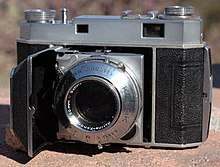
In the earliest days, the photographer had to load the film into reusable cassettes and, at least for some cameras, cut the film leader. In 1934, Kodak introduced a 135 daylight-loading single-use cassette. This cassette was engineered so that it could be used in both Leica and Zeiss Ikon Contax cameras along with the camera for which it was invented, namely the Kodak Retina camera. The Retina camera and this daylight loading cassette were the invention of Dr. August Nagel of the Kodak AG Dr. Nagel Werk in Stuttgart. Kodak bought Dr. August Nagel's company in December, 1931, and began marketing the Kodak Retina in the summer of 1934. The first Kodak Retina camera was a Typ 117. The 35 mm Kodak Retina camera line remained in production until 1969. Kodak also introduced a line of American made cameras that were simpler and more economical than the Retina. Argus, too, made a long-lived range of 35mm cameras; notably the Argus C3. Kodak launched 135-format Kodachrome color film in 1936. AGFA followed with the introduction of Agfacolor Neu later in the same year.
The designations 235 and 435 refer to 35 mm film in daylight-loading spools, that could be loaded into Leica or Contax style reusable cassettes without need of a darkroom. The 335 was a daylight loading spool for the 24 × 23 mm stereo format.
The reflex camera
Reflex viewfinders, both twin-and single-lens, had been used with earlier cameras using plates and rollfilm.
The first 35 mm single-lens reflex (SLR) was the Kine Exakta, introduced in 1936. World War II interrupted development of the type. After the war, Exakta resumed development and the Contax S model with the now familiar pentaprism viewing feature was introduced in 1949. In the 1950s, the SLR also began to be produced in Japan by such companies as Asahi and Miranda. Asahi's Pentax introduced the instant-return mirror, important for the popularity of SLRs; until then, the viewfinder on an SLR camera blanked as the mirror sprang out of the optical path just before taking the picture, returning when the film was wound on. Nikon's F model, introduced in March 1959, was a system camera that greatly improved the quality and utility of 35 mm format cameras, encouraging professionals (especially photojournalists) to switch from larger format cameras to the versatile, rugged, and fast SLR design. Numerous other film formats waxed and waned in popularity, but by the 1970s, interchangeable-lens SLR cameras and smaller rangefinders, from expensive Leicas to "point-and-shoot" pocket cameras, were all using 35 mm film, and manufacturers had proliferated.
Colour films improved, both for print negatives and reversal slides, while black-and-white films offered smoother grain and faster speeds than previously available. Since 35 mm was preferred by both amateur and professional photographers, makers of film stock have long offered the widest range of different film speeds and types in the format. The DX film-speed encoding system was introduced in the 1980s, as were single-use cameras pre-loaded with 35 mm film and using plastic lenses of reasonable enough quality to produce acceptable snapshots. Automated all-in-one processing and printing machines made 35 mm developing easier and less expensive, so that quality colour prints became available not only from photographic specialty stores, but also from supermarkets, drugstores, and big box retailers, often in less than an hour.
From 1996
In 1996, a smaller format called Advanced Photo System (APS) was introduced by a consortium of photographic companies in an attempt to supersede 135 film. Due in part to its small negative size, APS was not taken seriously as a professional format, despite the production of APS SLRs. In the point-and-shoot markets at which the format was primarily aimed, it enjoyed moderate initial success, but still never rivalled the market penetration of 135. Within five years of its launch, cheap digital compact cameras started becoming widely available, and APS sales plummeted.

Such digital compact cameras also eroded the market for 35 mm compact cameras. Digital SLRs at a price (and quality) comparable with consumer-level 35 mm SLRs were developed, further reducing the demand for 135 film. Most of these use so-called "APS-C" sized sensors, approximately 16×24 mm in size (half-frame). A few digital SLRs use "full frame" sensors, the same size as 135 film. Sales of all film sizes declined to a very large extent; of the remaining sizes, 135 is the most popular.
While they have shifted the vast majority of their product lines to digital, major camera manufacturers such as Canon and Nikon continue to make expensive professional-grade 35 mm film SLRs (such as the Canon EOS-1v and the Nikon F6). Introductory 35 mm SLRs, compact film point-and-shoot cameras, and single-use cameras continue to be built and sold by a number of makers. Leica finally introduced the digital Leica M8 rangefinder in 2007, but continues to make its M series rangefinder film cameras and lenses. A digital camera back for the Leica R9 SLR camera was discontinued in 2007. On March 25, 2009, Leica discontinued the R9 SLR and R-series lenses.[5]
See also
References
- "BS ISO 1007:2000 - Photography. 135-size film and magazine. Specifications". shop.bsigroup.com. Retrieved March 15, 2018.
- "The History of Kodak Roll Films". Archived from the original on February 22, 2009. Retrieved February 8, 2009.
- Popular Photography. February 1981. p. 68. ISSN 1542-0337.
- "Top 100 maximum valued cameras". Archived from the original on July 16, 2013. Retrieved July 2, 2013.
- "Leica cease production of R9 and R lenses". Leica Camera AG. March 25, 2009. Archived from the original on August 29, 2009. Retrieved July 9, 2015.
External links
